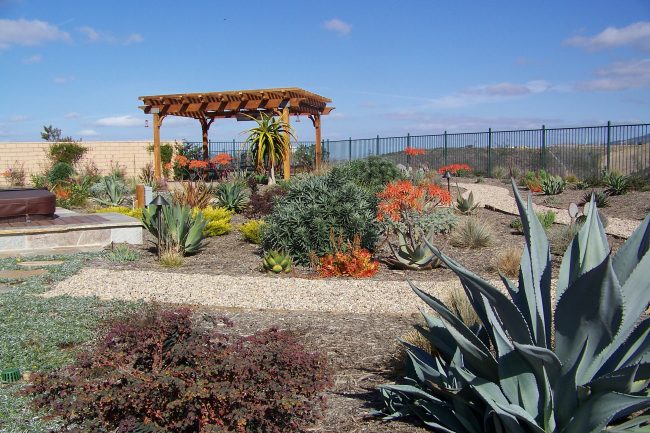
When people hear the words “desert landscaping” they immediately imagine cacti, driftwood, tumbleweeds, and a bunch of concrete. This is called zero-scaping, and though it is certainly an option that requires no maintenance, it is also a bit of a downer because there’s no personality to it. Just because you live in a dry climate and want to conserve water doesn’t mean your yard can’t be full of life. You want to embrace your natural setting while still retaining some color and foliage along the way.
Therefore, xeriscaping has become a very popular choice among homeowners. It literally translates from Greek as “dry scene” (xeriscape), and it helps to conserve water and energy by allowing a yard to match its natural landscape and climate. Why live in the desert and try to make your lawn look like a forest? Instead, embrace and showcase the setting.
Less Maintenance, More Savings
Though water conservation is one of the main benefits of xeriscaping, a lot of financial advantages can be reaped from this landscape as well. One of the biggest reasons to invest in “dry design” is not only because it is environmentally sound and aesthetically pleasing, but it also brings you big savings. You no longer have to fight the climate and force your lawn to act unnaturally. By giving into the landscape itself, you’re on the winning side of a losing battle. Preserving water isn’t just a smart thing to do; it saves you money on bills. You also don’t have to fertilize as much. There is less of a need for pest control and expensive chemicals. There will be less maintenance, less pruning, and no more wasteful trimmings. All of this will help save the environment while saving you time, effort, and money.
Preplanning
But, in order for it to be successful, there are certain preparations that need to be made. You’ll probably need to work with a professional landscaper to get it done right the first time, but here are some things to always keep in mind.
Ready to start your Landscaping Project?
Find ProsAppropriate Planting
First, any quality xeriscaping will need the right kinds of plants. Typically, these are native species that require less water and can withstand the heat. Although you want drought-tolerant plants, it doesn’t mean they all have to be cactus and yucca. In fact, there are many types of tough desert lawns, turfs, and flowers that grow bright and colorful. Buy plants that can be deeply rooted and are bred to endure harsh climates. Also, as you install your vegetation, make sure that you plant in groupings for better water efficiency.
Water Conservation
Conserving water is important, whether it’s your choice or the government’s. Buying plants that require less moisture will help, but there are other ways to preserve as well. First, try to invest in a drip-irrigation system. This sprinkler system runs along pipes throughout your lawn and slowly drips water directly onto the vegetation. It acts as a gentle rainfall or a dewy morning. This not only cuts down on wasteful inaccuracy (no need to water your home’s siding and driveway) and over-watering, it also prevents immediate evaporation into the air by high winds. But if you do use traditional sprinklers, make sure to water in the mornings or evenings when the soil is more primed to soak up moisture.
Soil Conservation
Desert soil is naturally impervious to water conservation. It quickly soaks it up, dries it out, and lifts if back into the atmosphere. An easy solution is mulching as much as possible. It cools off the ground, holds water, and cuts down on energy bills and maintenance costs. But you can also plan bigger projects, such as re-structuring your soil so that plants can retain any moisture for a longer period of time. It’s not easy, nor cheap, but once you’ve put time and energy into the initial investment, you’ll get a return on your money in no time.
One Last Tip
Though xeriscaping is a very popular trend in dry climates (such as the West and Southwest) it may not be as common or successful in other areas of the country. Therefore, check with your neighbors and homeowner’s association to see if this re-design is allowed. But even if desert landscaping itself isn’t permitted, the philosophy behind the design is still applicable. If you live in the Midwest or Northeast, match your yard to fit your region’s natural landscape and climate. Succumbing to the natural world, no matter where you live, will lead to less work and bigger savings.
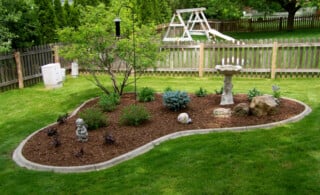 The Basics of Landscaping
The Basics of Landscaping 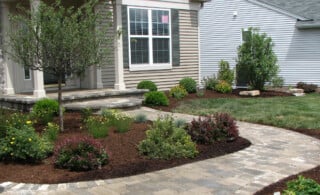 Ornamental Trees and Plants
Ornamental Trees and Plants 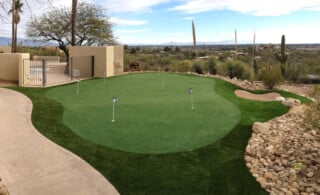 Artificial Putting Greens: The Ultimate Outdoor Entertainment
Artificial Putting Greens: The Ultimate Outdoor Entertainment 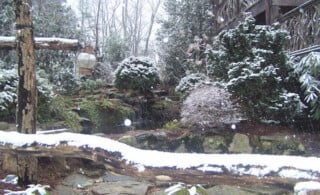 Checklist: Winter Landscape Tips
Checklist: Winter Landscape Tips  The Myths that Lead to Common Landscaping Mistakes
The Myths that Lead to Common Landscaping Mistakes 

Are You Familiar With This Topic? Share Your Experience.